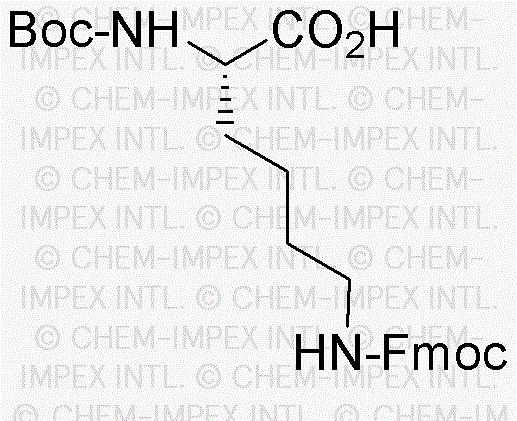Na-Boc-Ne-Fmoc-L-Lysine is widely utilized in research focused on:
- Peptide Synthesis: This compound serves as a key building block in the synthesis of peptides, allowing researchers to create complex molecules for drug development and biological studies.
- Protein Engineering: It is used in the modification of proteins, enabling scientists to enhance stability and functionality, which is crucial in biopharmaceutical applications.
- Drug Delivery Systems: The compound's unique properties facilitate the design of targeted drug delivery systems, improving the efficacy of therapeutic agents while minimizing side effects.
- Bioconjugation: It plays a significant role in bioconjugation processes, where it helps attach drugs or imaging agents to biomolecules, enhancing their therapeutic and diagnostic capabilities.
- Research in Cancer Therapy: Researchers leverage its properties to develop novel cancer therapies, as it allows for the precise modification of therapeutic agents to improve their targeting and effectiveness.
General Information
Properties
Safety and Regulations
Applications
Na-Boc-Ne-Fmoc-L-Lysine is widely utilized in research focused on:
- Peptide Synthesis: This compound serves as a key building block in the synthesis of peptides, allowing researchers to create complex molecules for drug development and biological studies.
- Protein Engineering: It is used in the modification of proteins, enabling scientists to enhance stability and functionality, which is crucial in biopharmaceutical applications.
- Drug Delivery Systems: The compound's unique properties facilitate the design of targeted drug delivery systems, improving the efficacy of therapeutic agents while minimizing side effects.
- Bioconjugation: It plays a significant role in bioconjugation processes, where it helps attach drugs or imaging agents to biomolecules, enhancing their therapeutic and diagnostic capabilities.
- Research in Cancer Therapy: Researchers leverage its properties to develop novel cancer therapies, as it allows for the precise modification of therapeutic agents to improve their targeting and effectiveness.
Documents
Safety Data Sheets (SDS)
The SDS provides comprehensive safety information on handling, storage, and disposal of the product.
Product Specification (PS)
The PS provides a comprehensive breakdown of the product’s properties, including chemical composition, physical state, purity, and storage requirements. It also details acceptable quality ranges and the product's intended applications.
Certificates of Analysis (COA)
Search for Certificates of Analysis (COA) by entering the products Lot Number. Lot and Batch Numbers can be found on a product’s label following the words ‘Lot’ or ‘Batch’.
Numéro de catalogue
Numéro de lot/série
Certificates Of Origin (COO)
This COO confirms the country where the product was manufactured, and also details the materials and components used in it and whether it is derived from natural, synthetic, or other specific sources. This certificate may be required for customs, trade, and regulatory compliance.
Numéro de catalogue
Numéro de lot/série
Safety Data Sheets (SDS)
The SDS provides comprehensive safety information on handling, storage, and disposal of the product.
DownloadProduct Specification (PS)
The PS provides a comprehensive breakdown of the product’s properties, including chemical composition, physical state, purity, and storage requirements. It also details acceptable quality ranges and the product's intended applications.
DownloadCertificates of Analysis (COA)
Search for Certificates of Analysis (COA) by entering the products Lot Number. Lot and Batch Numbers can be found on a product’s label following the words ‘Lot’ or ‘Batch’.
Numéro de catalogue
Numéro de lot/série
Certificates Of Origin (COO)
This COO confirms the country where the product was manufactured, and also details the materials and components used in it and whether it is derived from natural, synthetic, or other specific sources. This certificate may be required for customs, trade, and regulatory compliance.


